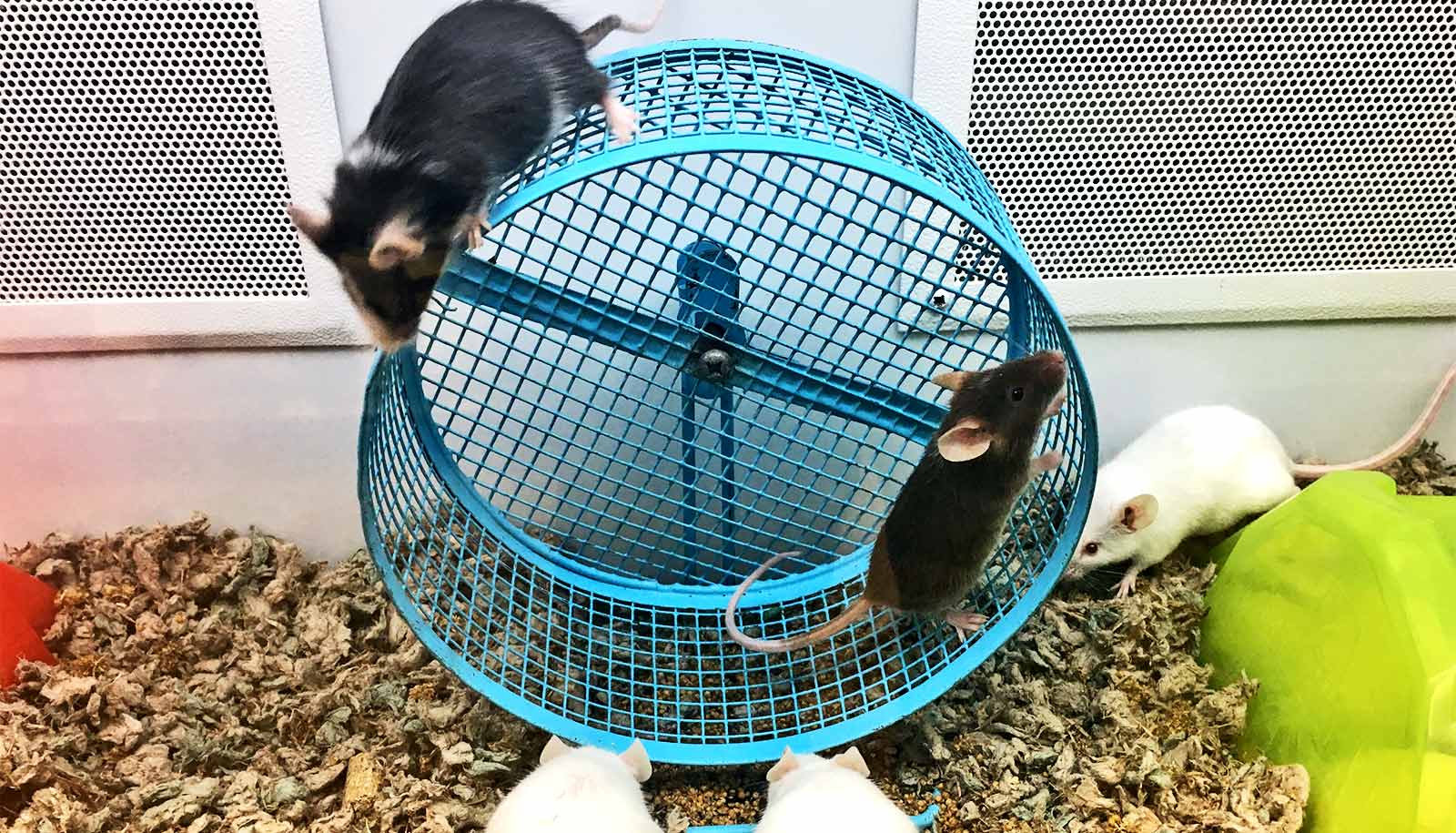A new study shows it’s possible to transfer the brain benefits marathon-running mice enjoy to their couch-potato peers.
The new research shows that blood from young adult mice that get lots of exercise benefits the brains of same-aged, sedentary mice. A single protein in the blood of exercising mice seems largely responsible for the benefit.
The discovery could open the door to treatments that—by taming brain inflammation in people who don’t get much exercise—lower their risk of neurodegenerative disease or slow its progression.
For the study in Nature, researchers compared blood samples from exercising and sedentary mice of the same age. They showed that transfusions of blood from running mice reduced neuroinflammation in the sedentary mice and improved their cognitive performance. In addition, the researchers isolated a blood-borne protein that appears to play an important role in the anti-neuroinflammatory exercise effect.
Neuroinflammation’s ties
Neuroinflammation has been strongly tied to neurodegenerative diseases in humans, says senior author Tony Wyss-Coray, professor of neurology and neurological sciences at Stanford University. Animal studies have indicated that neuroinflammation precipitates neurodegenerative disorders and that reversing or reducing neuroinflammation can prolong cognitive health, he says.
Anybody who’s suffered from influenza can relate to the loss of cognitive function that comes from a fever-inducing viral infection, Wyss-Coray says. “You get lethargic, you feel disconnected, your brain doesn’t work so well, you don’t remember as clearly.”
That’s a result, at least in part, of the body-wide inflammation that follows the infection. As your immune system ramps up its fight, the inflammation spills over into your brain. Neuroinflammation also exacerbates the progression of Alzheimer’s and other neurodegenerative diseases, says Wyss-Coray, a neuro-immunologist who in a study published earlier this year identified signs of brain inflammation in people who had died of COVID-19.
It’s already known that exercise induces a number of healthy manifestations in the brain, such as more nerve-cell production and less inflammation.
“We’ve discovered that this exercise effect can be attributed to a large extent to factors in the blood, and we can transfer that effect to a same-aged, non-exercising individual,” says Wyss-Coray.
Mice run 4-6 miles a night
Mice love to run. Give a caged mouse access to a running wheel a few inches in diameter and, with no training or prompting, it will rack up 4 to 6 miles a night (they sleep by day) on legs that are much shorter than ours. If you lock the wheel, the mouse won’t log nearly as much exercise, although it’s still free to skitter hither and thither about its cage (roughly equivalent to heading into the kitchen now and then to fetch a beer or a snack from the fridge).
The investigators put either functional or locked running wheels into the cages of 3-month-old lab mice, which are metabolically equivalent to 25-year-old humans. A month of steady running was enough to substantially increase the quantity of neurons and other cells in the brains of marathoner mice when compared with those of sedentary mice.
Next, the researchers collected blood from marathoner and, as controls, sedentary mice. Then, every three days, they injected other sedentary mice with plasma (the cell-free fraction of blood) from either marathoner or couch-potato mice. Each injection equaled 7% to 8% of the recipient mouse’s total blood volume. (An equivalent amount in humans would be about 50 to 75% of a pint.)
“The mice getting runner blood were smarter,” Wyss-Coray says. On two different lab tests of memory, sedentary mice injected with marathoner plasma outperformed their equally sedentary peers who received couch-potato plasma.
In addition, sedentary mice receiving plasma from marathoner mice had more cells that give rise to new neurons in the hippocampus (a brain structure associated with memory and navigation) than those given couch-potato plasma transfusions.
The scientists compared activation levels of thousands of genes in the hippocampus of sedentary mice receiving marathoner versus those receiving couch-potato plasma. Of the roughly 2,000 genes whose activation levels changed in response to marathoner plasma, the 250 whose activation levels changed most prominently were known to be most strongly linked to inflammatory processes, and their activation-level changes suggested lower neuroinflammation among mice who received marathoner-blood transfusions.
“The runners’ blood was clearly doing something to the brain, even though it had been delivered outside the brain, systemically,” says Wyss-Coray.
Turning to an examination of proteins in the marathoner mice’s blood, the researchers identified 235 distinct proteins, of which 23 were scarcer and 26 more abundant in marathoner compared with couch-potato mice.
Several of these differentially expressed proteins were associated with the complement cascade—a set of about 30 blood-borne proteins that interact with one another to kick-start the immune response to pathogens. Chronic inflammation resulting from aberrant activation of the complement system, Wyss-Coray notes, appears to accelerate the progression of many neurodegenerative disorders.
Just 1 protein
Removing a single protein, clusterin, from marathoner mice’s plasma largely negated its anti-inflammatory effect on sedentary mice’s brains. No other protein the scientists similarly tested had the same effect.
Clusterin, an inhibitor of the complement cascade, was significantly more abundant in the marathoners’ blood than in the couch potatoes’ blood.
Further experiments showed that clusterin binds to receptors that abound on brain endothelial cells, the cells that line the blood vessels of the brain. These cells are inflamed in the majority of Alzheimer’s patients, notes Wyss-Coray, whose research has shown that blood endothelial cells are capable of transducing chemical signals from circulating blood, including inflammatory signals, into the brain.
Clusterin by itself, even though administered outside the brain, was able to reduce brain inflammation in two different strains of lab mice in which either acute body-wide inflammation or Alzheimer’s-related chronic neuroinflammation had been induced.
Separately, the investigators found that at the conclusion of a six-month aerobic exercise program, 20 military veterans with mild cognitive impairment, a precursor to Alzheimer’s disease, had elevated clusterin levels in their blood.
Wyss-Coray speculates that a drug that enhances or mimics clusterin’s binding to its receptors on brain endothelial cells might help slow the course of neuroinflammation-associated neurodegenerative diseases such as Alzheimer’s.
Zurine De Miguel, a former postdoctoral scholar in Wyss-Coray’s group who is now an assistant professor of psychology at California State University, Monterey Bay, is the study’s lead author.
Funding came from the National Institutes of Health, the US Department of Veterans Affairs, the US Department of Defense, the Alzheimer’s Association, the Marie Curie Foundation, the NOMIS Foundation, the Simons Foundation, and the Wu Tsai Neurosciences Institutes’ Brain Rejuvenation Project with support from the Bertarelli Foundation.
Source: Stanford University


